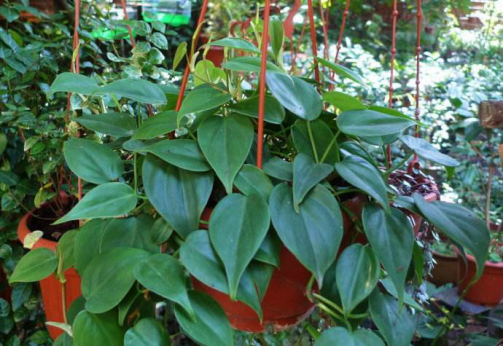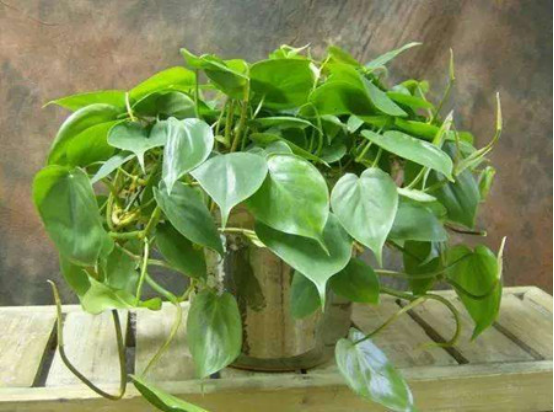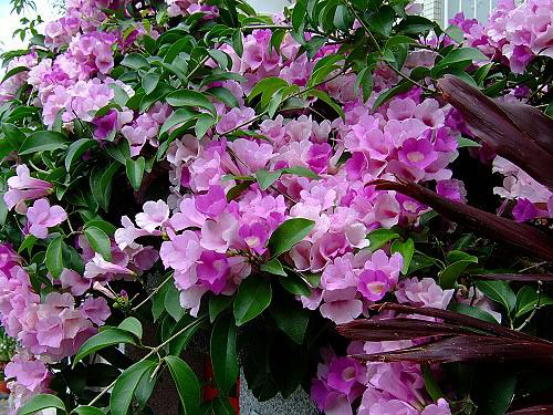Is it appropriate to plant heart leaf vine at home?
Heart leaf vine is suitable for growing at home, because heart leaf vine is very suitable for growing at home both in appearance and in terms of its performance and efficacy. In appearance, the thick and full-bodied green leaves can make a family full of vitality; in effect, the vine has the functions of cleaning dust, removing impurities in the air, purifying the air and providing oxygen. The growth ability of the heart leaf vine is quite exuberant, as long as in a cool and humid place, the heart leaf vine can grow. Therefore, the heart leaf vine is more suitable for planting at home.

So, is there anything you need to pay attention to when raising heart leaf vine at home?
1. Lighting
Heart leaf vine for the sun is not high requirements, daily need to maintain four or five hours of light, can also be exposed to the sun for a long time, should pay attention to the sun is not too strong. The heart leaf vine is more prone to frostbite, so it is necessary to pay attention to prevent frostbite at night and take appropriate measures to keep warm in the cold winter.
2. Humidity
Because the humidity is different in different regions and different seasons, and the requirements for humidity are also different. In the summer sun exposure time is relatively long season, easy to occur drying phenomenon, so at this time need appropriate more watering. In winter, water evaporates slowly, so you can reduce the number and quantity of watering, and be careful not to water at noon.
3. Temperature
The heart leaf vine likes to grow up in an environment with a temperature of about 10 degrees Celsius, so the demand for temperature is relatively high. Daily planting needs to pay attention to temperature control, to prevent Guoqiang ultraviolet rays from affecting the growth of heart leaf vine in summer, and to do a good job of heat preservation in winter.
In fact, the heart leaf vine is very suitable for growing in the home of a green plant, and it is easy to feed, do not plant a pot of heart leaf vine at home!
The value and ornamental value of Tripterygium paniculata
There is no need to say much about the origin of the alias "emerald". Since it is named after a gemstone, then the ornamental value will not be bad! Heart leaf rattan leaf color is dark green, evergreen all the year round, the leaf shape is special, very similar to the heart-shaped, is a very elegant foliage plant, its ornamental value is very high!
Purification effect
Heart leaf vine is very suitable for decorating indoor occasions. In addition to beautifying the environment and greening decoration, it can also purify the air and absorb harmful gases, which is very beneficial to human health. Putting a pot of heart vines in the house is not only pleasing to the eye, but also good for the body. Why not do it?
The above is about the pruning of Tripterygium wilfordii. Does it solve your problem? Thank you for your reading!
Culture method of Tripterygium wilfordii 1. Supplementary fertilizers:
The heart-leaf vine needs to apply water-soluble fertilizer during the growing season, which is beneficial to the initial growth of the heart-leaf vine, which can be fertilized once or twice a month; on the contrary, it needs to stop fertilization in autumn and winter, because the heart-leaf vine almost stops growing in autumn and winter.
two。 Moisture requirements:
Xinyeteng prefers a semi-overcast and warm and humid climate, so it is obvious that its basin soil should be kept moist, especially in hot summer. It should be noted that when spraying water, it is necessary to spray water to the leaves, and to prevent the accumulation of water in the basin soil, otherwise the heart leaf rattan will not live long. Once a day in summer, once every three to five days in autumn, and try to keep it not completely dry in winter.
3. Daily maintenance:
Cutting, sowing, ramet and tissue culture are commonly used. Cuttings are the most popular. From May to September, take 2 ~ 3 nodes of robust stem and insert them into coarse sand to keep the environment moist. The temperature is 22 ~ 24 ℃, and it will take root 20 ~ 25 days after insertion. Sowing and propagation is to use indoor seedling tray sowing, the optimum temperature for germination is 25%-30%, germinate 10-15 days after sowing, wait until the seedling height 5-6 cm is moved to 8 cm pot. Ramet propagation is that when the plant grows taller, the side branches with aerial roots should be potted directly or picked first to help to have more branches, and when the side branches are 15-20 cm, cut off for pot planting.
- Prev

Culture method of Tripterygium paniculata
1. Supplementary fertilizer: the heart-leaf vine needs to apply water-soluble fertilizer during the growing season, which is beneficial to the initial growth of the heart-leaf vine, which can be fertilized once or twice a month; on the contrary, it needs to stop fertilization in autumn and winter, because the heart-leaf vine almost stops growing in autumn and winter
- Next

Planting method of garlic vine
The main results are as follows: 1. If you want to plant garlic rattan at home, the requirement for the choice of flowerpot is relatively high. At this time, we should choose flowerpots suitable for garlic vine climbing or fishing, but for soil requirements, we should avoid choosing too moist and impervious soil, and choose relatively loose and smooth soil.
Related
- Fuxing push coffee new agricultural production and marketing class: lack of small-scale processing plants
- Jujube rice field leisure farm deep ploughing Yilan for five years to create a space for organic food and play
- Nongyu Farm-A trial of organic papaya for brave women with advanced technology
- Four points for attention in the prevention and control of diseases and insect pests of edible fungi
- How to add nutrient solution to Edible Fungi
- Is there any good way to control edible fungus mites?
- Open Inoculation Technology of Edible Fungi
- Is there any clever way to use fertilizer for edible fungus in winter?
- What agents are used to kill the pathogens of edible fungi in the mushroom shed?
- Rapid drying of Edible Fungi

